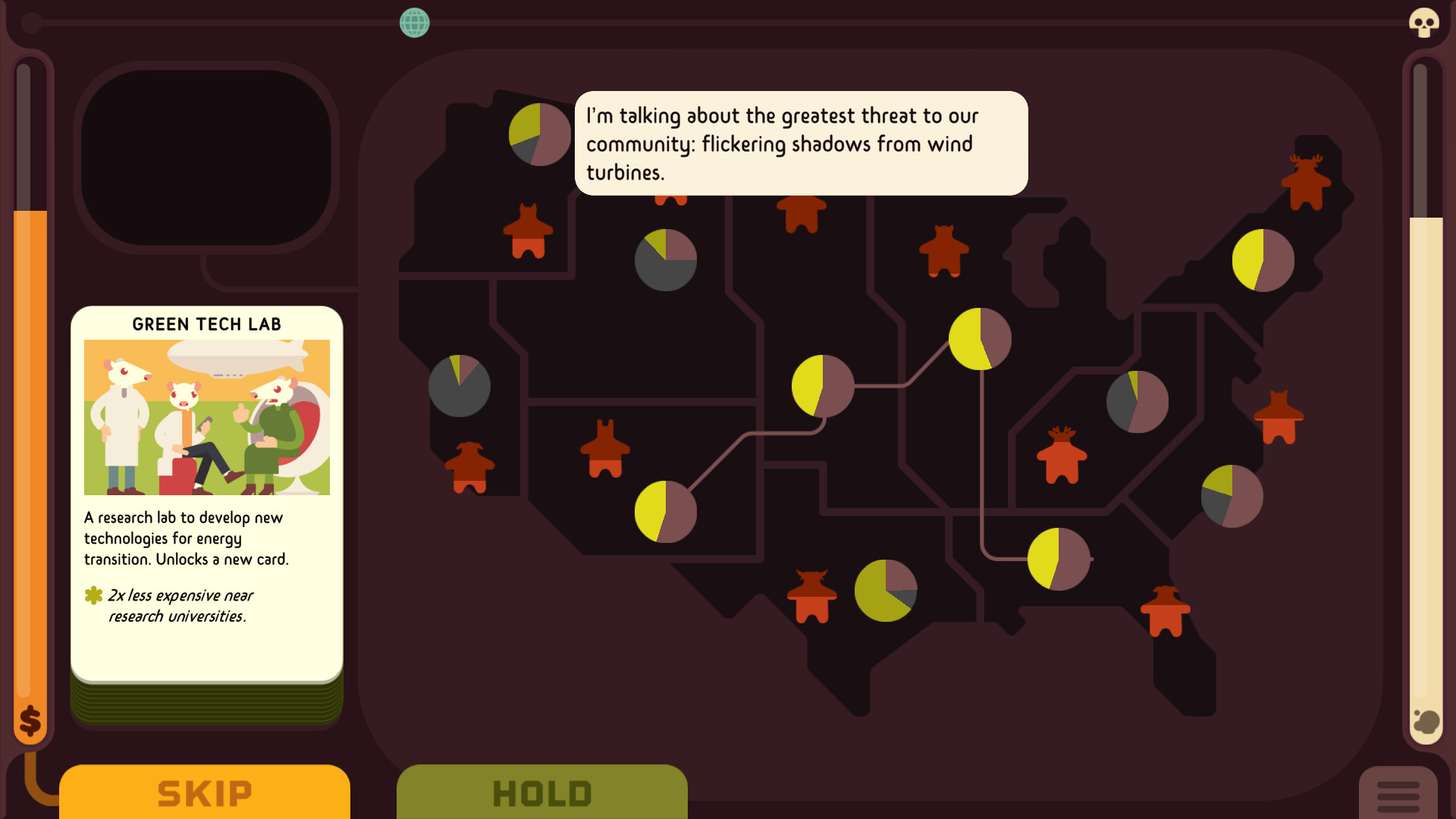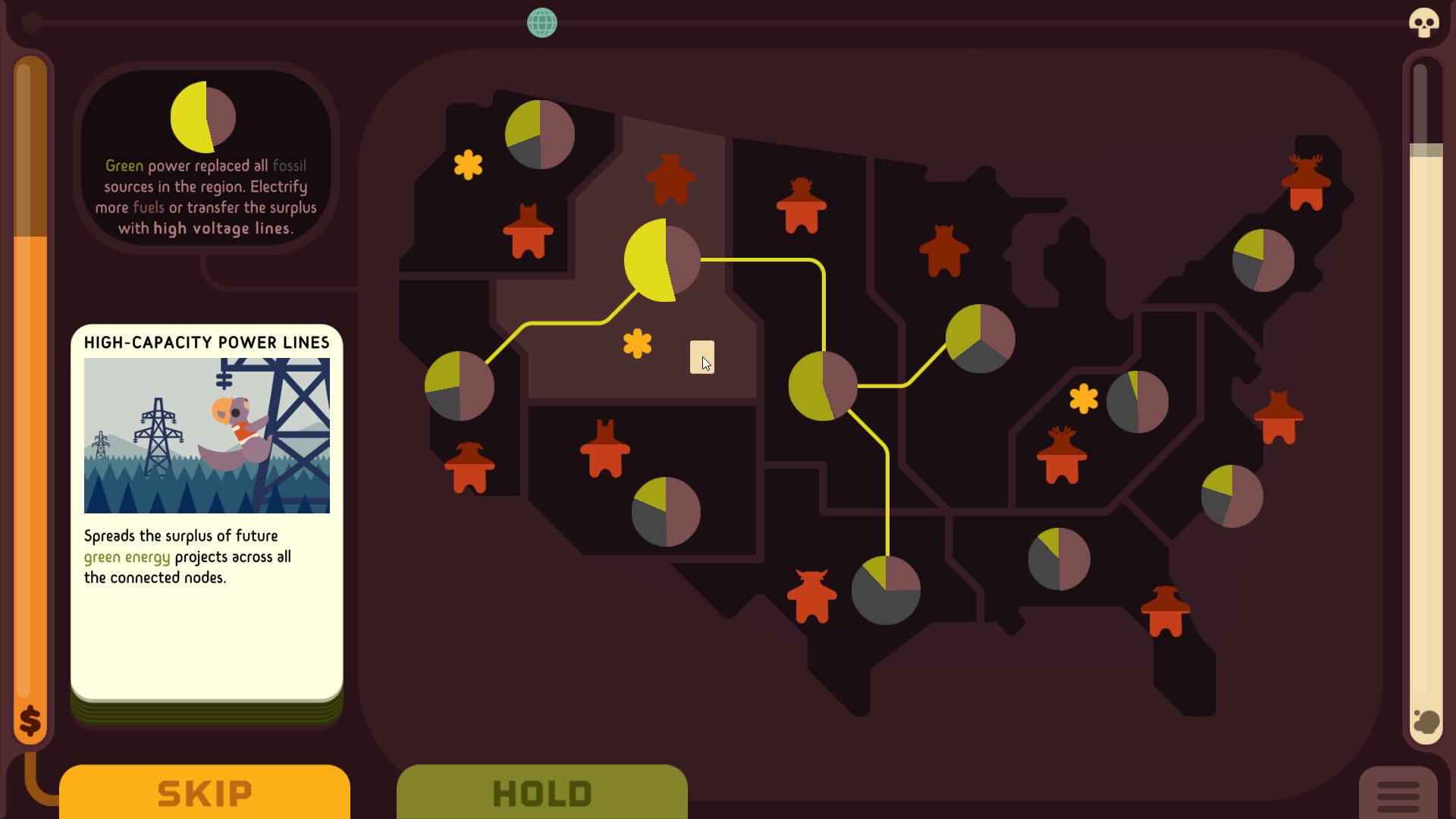The Green New Deal Simulator is out and free to play on all the main operating systems.
It’s a spiritual sequel of the Democratic Socialism Simulator, in that they share the same visual style, simple drag-and-drop interactions, and short-term practical utopianism.
When it comes to climate change, we are well past the “raising awareness” phase of the discourse; we need culture that raises awareness of the solutions, which are:
1) technological, infrastructural, and cultural
2) already available (at least to all the industrialized nations) and
3) inevitably threatening the existing economic and political powers.
I wanted the GND Simulator to be an accessible, almost child-friendly, catalog of these solutions and their challenges.
Even if climate change is a global issue, I was aiming for a certain geographic specificity. There are several recent games representing climate issues in a proactive, utopian, and systemic way. Half-Earth Socialism posits a global ecosocialist revolution as a prerequisite for a just energy transition; Beecarbonize abstracts a wide range of policies that the player implements as an undefined, global, collective consciousness; Terra Nil postpones ecosystem restoration to a post-apocalyptic and possibly post-human, future.
To be clear, these are all excellent titles, but I felt the need to tackle climate change as something that has to be done right here, right now, and without the need of entirely new political and economic structures. There is a chance we won’t bring down capitalism in the next 20 years or so, and that’s the timeframe we have to avoid irreversible environmental damage.
The original plan was to have three scenarios: USA, Europe, and China, with slightly different mechanics pointing at the different degrees of state agency. It turned out to be too complicated for the time I allocated, but there may be expansions if there is enough interest. Besides, the United States is the biggest emitter, historically and cumulatively speaking, and arguably the most politically resistant to climate policies.

The gameplay is more complex (and less proven) than the Democratic Socialism Simulator, incorporating a map, a bit of deck-building, and a few more moving parts.
While the DSS was primarily about what reforms we should enact, the GND Simulator is more concerned with where the investments should go.
Rural regions, in particular in non-coastal and southern states, will play an outsized role in the energy transition due to their higher potential for renewables. This presents a challenge because they are the least progressive (i.e. Republican) areas in the current political terrain.
This challenge can be turned into an opportunity to achieve consensus on climate issues, because a green transition means jobs and state-driven development in regions ravaged by neoliberal policies.
Therefore, negotiating employment and emission reduction goals is a core mechanic in the game, reflecting a central tenet of the Green New Deal.
Another important design choice was the differentiation between fossil fuels for electric power generation, and fuels for heating and transportation (gasoline and natural gas). This is the aspect that confused my playtesters the most, but it’s a crucial communication goal: you don’t save the world by driving an electric car if the electricity is created by burning fossil fuels. Conversely, transitioning the grid to wind and solar won’t automatically take care of a big chunk of emissions that are not related to electricity. I hope to convey that electrification and the development of renewables are interrelated but distinct problems.

I also wanted to communicate the importance of energy infrastructure. The highest potential for renewables is in sunny deserts or windy mountainous regions. That’s not where most Americans live! Transferring massive amounts of energy across the United States will require high voltage power lines that are simply not there yet. In order to make intermittent sources like solar or wind more reliable we will need pumped storage hydropower, batteries, and more sophisticated “smart” grids. Infrastructure is less photogenic than wind turbines and electric cars, but it will be a major aspect of the energy transition.
A design pillar very dear to me is “No Exposed Numbers”. All the quantities in the game are expressed visually through bars and charts. This strategic vagueness is meant to encourage a more qualitative approach to the issues.
There is some research informing the variables and the algorithms in the game, but any game model will have to resort to gross simplifications to be even vaguely playable.
The use of “simulator” in the title is in line with the ironic contemporary usage, as in: Goat Simulator. I want people to keep in mind that this is fundamentally a fable with talking animals, an interactive toy, and not a scientific model. I maintain that all games claiming to be realistic, or based on real data are misleading their players. When it comes to complex systems, realism is just an aesthetic.
Since the map is fixed and the cards are limited, the GND Simulator may have a puzzle-like vibe, but there are multiple pathways to decarbonization. There is also no silver bullet: you cannot win by only using nuclear power or carbon capture.
There are so many aspects of the energy transition I couldn’t fit into the game. That’s the downside of making a small, minimalistic game about the most complex challenge the human race has ever faced.
